Pros
Cons
Physical Tour
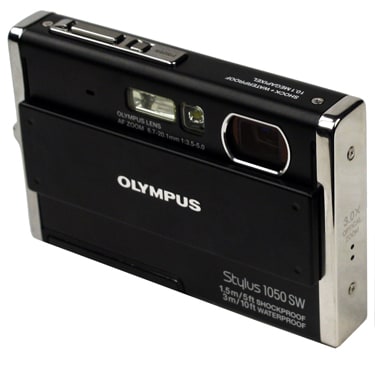
Front(8.75)
The 1050 SW employs the kind of sliding lens cover we associate with Sony's Cyber-shot line. It slides down easily, with a convincing snap, to both turn on the camera and reveal the lens and flash below. The lens is positioned on the top right side of the camera body, the flash in the top center, with the dual-purpose LED auto focus assist / self-timer lamp perched between the two. To the left of the lamp is a small opening for a mono microphone.
The body of the camera is colored in a matte finish, framed by silver edges left and right. The Olympus name appears in raised silver lettering on the lens cover, the lens specs (OLYMPUS LENS AF ZOOM 6.7-20.1mm 1:3.5-5.0) are printed in white below the flash. At the bottom right of the camera are the camera name and its school of hard knocks promises: 1.5m/5ft SHOCKPROOF, 3m/10ft WATERPROOF. At the lower left you can see the side of the door protecting the battery and memory card compartment on the camera bottom.
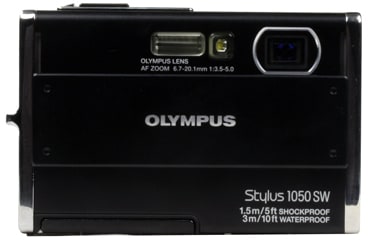
A full-width lens cover that slides vertically
is both good-looking and practical.
Back (7.00)
The back of the camera is mostly screen, a 2.7-inch LCD with the typical 230,000-dot resolution. The OLYMPUS name and 'HyperCrystal LCD' are printed in white below the screen.
Camera controls are arrayed along a 1-inch strip down the right side. Starting at the top, these include the zoom control, mode dial, and a four-way controller with additional buttons nestled between its pivoting arms. The mode dial has eight positions: Auto, Program, Anti-shake, Scene, Guide, Movie, Favorite and Playback. The arms of the four-controller handle (clockwise from the top) exposure compensation, flash mode, self-timer and macro mode. In the center is the OK/FUNC button.
The four additional buttons around the four-way are (clockwise from the northeast) Playback/Print, Shadow Adjustment/Erase, Information Display/Menu Guide/LED illuminator and MENU.
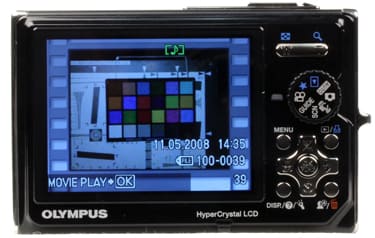
As long as your thumbnails haven't been chewed down to a nub
you should be able to manage the 1050 SW controls.
Left Side* (5.00) *The left side is, for the most part, shiny silver and unadorned. Two small holes serve no apparent purpose (the microphone is on the camera front, the speaker on the right side), the 3.0X OPTICAL ZOOM label is printed in white, and there are two visible screws attesting to the camera's rugged construction.

Visible screws are clues to the camera's
solid construction.
At the top is a convincingly waterproof door, with a design that shows no signs of ever popping open accidentally and a substantial waterproof gasket within to protect the combination USB/video out port. In the middle is a substantial connecting point for the wrist strap, with a hole large enough to make threading simple. The lower right is home to a small speaker.
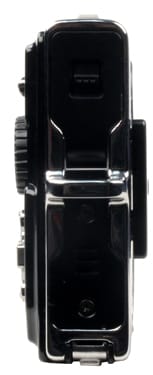
*The I/O port cover on top is well
sealed against moisture.
*
The top controls are very simple: the shutter button on the right side and a power button to its left. The only function the Power button really serves is turning on the camera when the mode dial is set for Playback, or if the camera has automatically shut down in power-saving mode. With any other setting, pressing Power without first lowering the lens cover makes the camera very angry, emitting a shrill piercing tone and displaying an exclamation-pointed warning that THE LENS BARRIER IS CLOSED. Printed in white along the left side is the legend SHOCK + WATERPROOF 10.1 MEGAPIXEL.

The shutter has a good tactile feel.
**
Bottom* (6.75)*
The camera bottom is most notable for it's industrial-grade door shielding the battery and memory card compartment. The sliding latch is nicely recessed to avoid accidental opening but yields easily enough to a well-placed fingernail, springing open to reveal its contents. The edges of the chamber are not as tightly sealed as the 1030 SW (makes sense, given their very different waterproofing ranges), but still impressively secure.
It seems strange that, with a camera body built of sturdy metal, the tripod socket is made of plastic. Maybe this is seen as a low-importance feature for an outdoorsy camera, but we feel this was an unfortunate cost-cutting decision.
The battery is held in place with a small red tab to keep it from falling out while the door is open, and the xD card slides easily into place. One ongoing problem we had involves that battery: it's completely symmetrical and practically begs to be inserted upside down, which we did frequently. Ultimately you figure out that the word OLYMPUS printed on the battery faces toward the front of the camera, but we were slow learners in this regard.

The battery/memory compartment door feels rugged and secure.
Color and Resolution
The 1050 SW may be right at home underwater or high on a ski slope, but it was less than comfortable in our testing labs. Results for color accuracy and low light performance were OK, but just about everything else was decidedly sub-par, and the white balance test was a train wreck.**
Color **(6.23)
When it comes to color, we haven't figured out a way to test for pretty yet, though admittedly that's what many people want in their digital cameras: bluer than blue skies, pinker than pink cheeks, and so on. We're limited here to measuring color accuracy, which in the age of inexpensive and easy photo editing strikes us as more important anyway. It's far easier to tweak a photo to meet your particular personal preferences if it starts out reproducing precisely what you saw when you took the shot. With that in mind, we shoot an industry-standard GretagMacbeth color chart under bright, controlled studio lighting, then analyze the resulting images using Imatest software to determine how closely the photo produced by the camera reproduces the known colors on the chart. The chart below is one revealing part of the Imatest analytical output. The squares correspond to the twenty-four color blocks of the GretagMacbeth chart. In each square, the outer rectangle is the color as captured by the camera, the inner square is the chart color corrected to match the luminance of the camera image, and the small inset rectangle reproduces the original chart color.
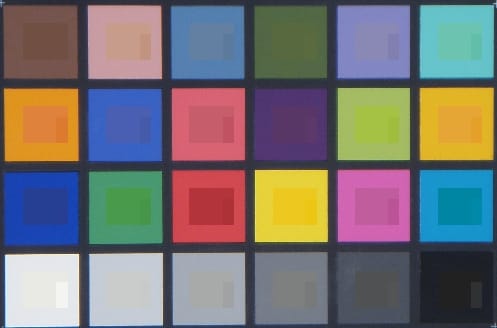
- *
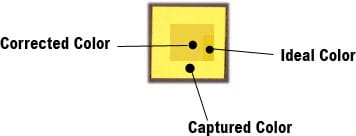
The same information is displayed in a more stastical way in the following chart. In this case, the captured color is displayed in the circles, the ideal color is shown in the squares, and the length of the line connecting them reflects the difference between the two: longer lines, less accurate color. And overall, color accuracy here is adequate but not particularly impressive. Flesh tones (roughly represented by the number 1 and 2 patches on the GretagMacbeth chart) are pretty close, as are the blue sky colors. Orange, yellow, green and cyan, though, are notably shifted, not just in saturation, but in hue as well. The entire image is slightly oversaturated, but not enough to cause loss of detail in the photo.
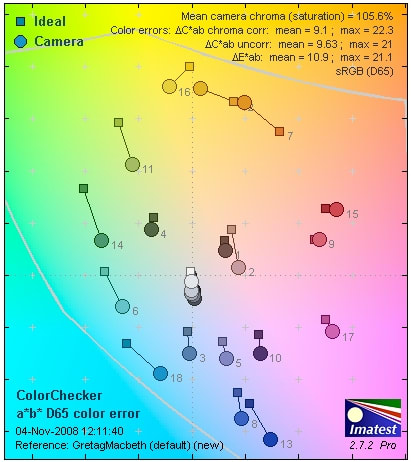
*Longer lines for green and orange shades indicate
less accurate color reproduction.
*
Color performance for the 1050 SW is adequate, but certainly not a selling point for the camera. Fortunately, the most accurate results come in precisely the colors where errors are most noticeable.
For comparison purposes, we're displaying the 1050 SW performance results against four other cameras we've reviewed. The Fujifilm FinePix F60fd and Samsung TL34HD are similarly sized point-and-shoot cameras at the same $299 price as the Olympus. The 1030 SW and Optio W60 are waterproof cameras, like the 1050 SW, though certified for different depths. While the Stylus 1050 SW did surpass its brand-mate's color accuracy, it significantly trailed the rest of the field.
**
**
Olympus 1050 SW Color Scores
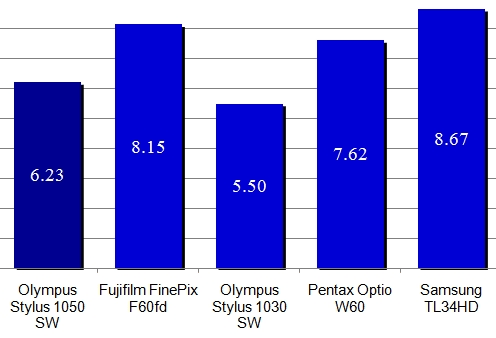
Resolution (5.81)
The sharpness of an image isn't measured in megapixels: in fact, too many megapixels squeezed into a small sensor can actually cause a significant loss of image quality compared to a lower-megapixel camera. To test the bottom-line resolution of a camera, we photograph a chart under bright light, at several distances, and analyze the resulting images using Imatest. Resolution is measured in line widths per pixel height (lw/ph). The higher the figure, the more increasingly fine detail can be distinguished by the camera before an area turns into an amorphous gray blob.
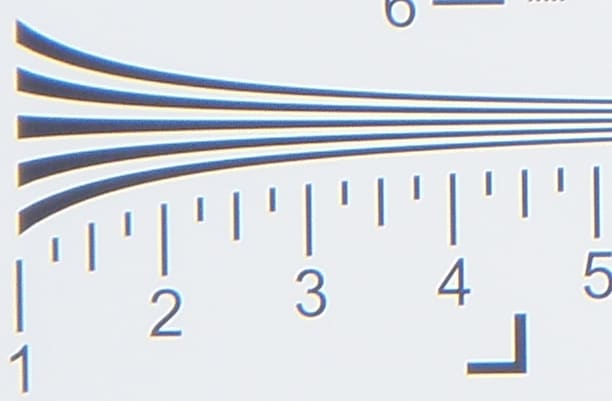
*In the detail shown here, resolution performance isn't great,
and there's noticeable color fringing.*
The top resolution results were 1526 lw/ph horizontally and 1225 vertically, which is unimpressive. And while the Fujifilm and Samsung results are dramatically superior (the Samsung delivered 2162 lw/ph horizontally and 2127 lw/ph vertically), even the two other waterproof cameras in our comparison group handily outperformed the 1050 SW.
Olympus 1050 SW Resolution Scores
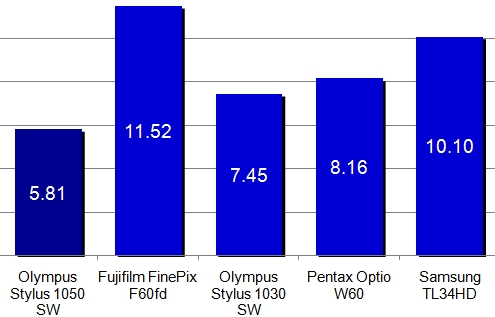
**Dynamic Range** (5.38)
A camera's ability to reproduce both the bright areas and the darker sections of an image, without losing detail at either extreme, is measured as dynamic range. This is measured in our labs by photographing a backlit chart that displays blocks of grayscale values from pure white on one end to solid black on the other, then analyzing the photos to determine the camera's breadth of coverage throughout its ISO range.
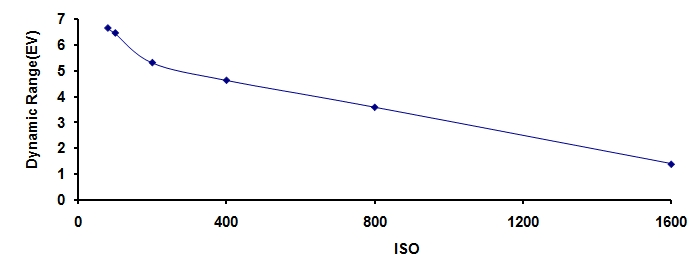
The curve plotted above does not represent a pretty picture. At the lowest available ISO settings (ISO 80 and 100), the 1050 SW performs very nicely, but loss of dynamic range from that point on is distressingly swift. Even without pushing the camera to its ISO 1600 extreme (which is really not that extreme, in a market where ISO 3200 for a compact camera is not uncommon), dynamic range limitations will be reflected in a lack of crispnesss and realism in high-contrast images.
Olympus 1050 SW Dynamic Range Scores

Here again, comparison is not flattering, with a significant drop in dynamic range performance even when compared against the brand-mate Stylus 1030 SW.
White Balance (3.84)
Except in fairly extreme lighting conditions – reading by candlelight, for example – we're not very sensitive to the color of the light around us. Looking at a sheet of paper under fluorescent light or a standard household bulb, for example, our minds adjust for the substantial difference between the two source of illumination and basically see the paper as white. This adjustment is far more difficult for a camera than it is for the human brain, but it's necessary to produce a good-looking photo. Most cameras offer at least two ways of coping with this challenge: an automatic system which lets the camera analyze the incoming light and adjust accordingly, and a set of presets tuned to specific light sources, which the user can choose manually. We test both of these strategies under a range of lighting conditions.
Most often we find that a camera will cope well with certain light sources and go down to defeat with others. This is certainly the case with the 1050 SW. Interestingly, one of the light sources that proves most challenging for compact cameras, fluorescent bulbs, was a strong point for the 1050 SW, and it also handled flash with good results. However, colors were wildly off in shots taken in the shade, and photos taken under tungsten lighting (similar to ordinary household bulbs) showed an uncomfortable shift towards overly warm and orange tones.
In the test images below, produced by Imatest image analysis software, the differences between ideal and actual colors have been exaggerated to show the nature of the color shift more clearly. You wouldn't see this level of difference in actual photos shot with the camera.
-
**Preset (3.66)
*Using the manual presets produced marginal improvements in the fluorescent and daylight shade categories, but only increased the off hues of tungsten-illuminated photos. There is no flash preset, hence the lack of a result in the samples below.
The good white balance performance achieved using flash and under fluorescent light was heavily outweighed by surprisingly poor scores in daylight shade and incandescent lighting. Using flash indoors will help some, but it's no solution to an overall disappointing result. While the Samsung is the obnovious kid who spoils the curve for the rest of the class in the comparison below, the 1050 SW lags significantly behind even average performers.
Olympus 1050 SW White Balance Scores
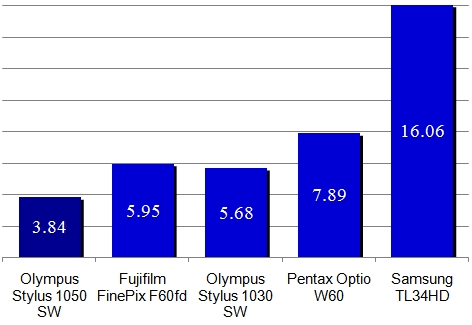
Noise and Video
**
Noise
**Image noise is the visible speckling you see if you look closely at areas of smooth color in a digital photo. Generally speaking, if you're just going to look at your photos on a computer screen or output 4x6' prints, moderate levels of image noise won't be very noticeable. However, as soon as you start cropping and enlarging a section of an image significantly, or tweaking your photos using image editing software, the grainy-looking image noise imperfections can become a major distraction.
To test for noise performance, we shoot a well-lit color chart, at all available ISO levels, then analyze the resulting images using Imatest software.
Noise – Manual ISO*(4.85)*
We expect to see image noise increase as ISO settings increase, but the 1050 SW started out with a lot of image noise at ISO 80 and 100, and the situation quickly got worse as the light sensitivity was raised. It looks like the camera tried to use a digital noise reduction filter after it passed ISO 400, but it didn't help much.
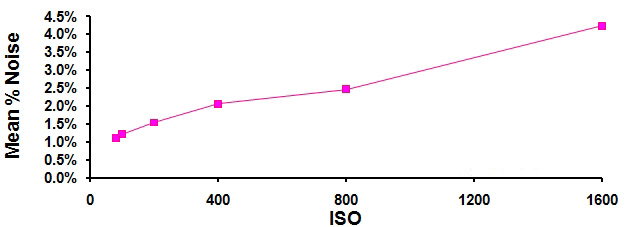
The margin of difference between the 1050 SW and the Fujifilm and Pentax cameras isn't terribly significant, though it's surprising to see the Olympus 1030 SW surpass the new 1050 SW by a substantial margin.
Olympus 1050 SW Manual Noise Scores
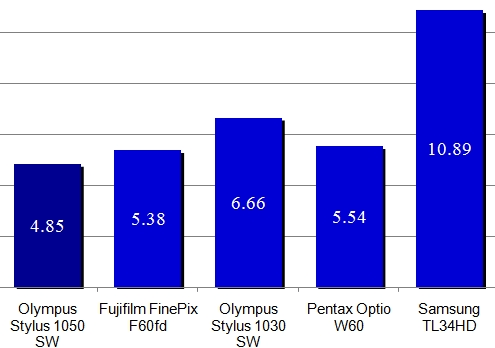
For this test we set the camera to Auto ISO and let it choose an appropriate setting for our well-lit lab chart. Many compact cameras fall down here by choosing a higher-than-necessary ISO setting, and since higher ISO translates to higher image noise, come up with low scores. In this case, the 1050 SW shot at ISO 200, a not unreasonable setting, but its poor overall noise profile still left it near the bottom of the pack.
Olympus 1050 SW Auto Noise Scores
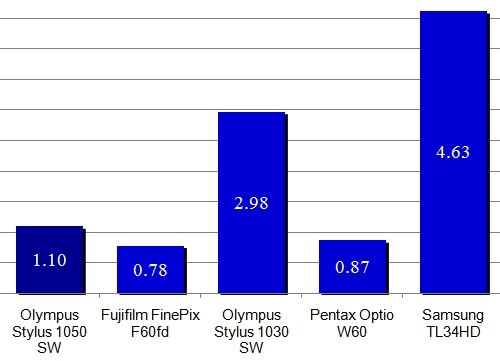
**Low Light **(5.57)
In our white balance testing, we determined that the 1050 SW does a nice job reproducing colors accurately when using flash. That doesn't make it any less obnoxious to walk around a party blasting a flash into peoples' faces, though, or startling that adorable baby with a couple thousand lumens in the puss. To avoid harsh lighting and calling attention to our candid photography efforts, we want our cameras to shoot well even in challenging low-light situations. To test this ability, we shoot our color chart at four illumination levels, ranging from 60 lux (a comfortable indoor lighting level) down to 5 lux (roughly the illumination from a single candle), and analyze these photos for color accuracy and image noise.
As you can see in the Imatest charts above, the 1050 SW performed reasonably well under low lighting. Color values aren't spot-on, but they are as accurate as we expect from a compact camera, and the performance is very consistent across the widely differing light levels.
We also test for long exposure performance, ideally with shutter speeds ranging up to 30 seconds, but this is often impossible with compact cameras. Many, like the Olympus 1050 SW, offer no direct control of shutter speed and, even when shutter speed control is provided, the longest exposure generally falls far short of half a minute. In this case, we were able to tease out a 1-second exposure by using the camera's Night Scene mode, which produced a decent image, consistent with the performance we found elsewhere in our testing: reasonable color accuracy, higher-than-desired image noise.
Overall, the 1050 SW falls in with the rest of the pack on low light performance, though again it comes up short when compared to the admittedly pricier 1030 SW.
Olympus 1050 SW Low Light Scores
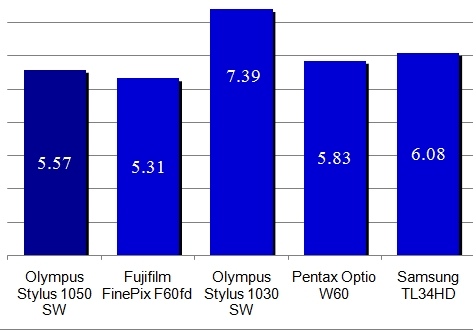
Still Life
For each review we shoot the same two scenes, our happy manequin couple on the couch and a diorama featuring Rosie the Riveter and her friends, at each available ISO level, using the camera's automatic exposure setting under fluorescent light. For comparison purposes, the full-size images are available by clicking on the thumbnails below. The original files are large, so beware, all ye with slow Internet connections.
**Video Performance ***(5.80) **
*For a camera designed with an active lifestyle in mind, the video mode has special importance: those YouTube moments when your snowboarding buddy becomes one with a pine tree that didn't jump out of his way fast enough are aching to be captured with the water- and cold-resistant 1050 SW. To see if the camera was up to the job, we started by measuring color and noise performance under two types of illumination – very bright 3000 lux lighting and subtler 30-lux illumination. All our video tests are conducted by shooting a few seconds under controlled lab conditions, grabbing frames from the sequence and analyzing these images using Imatest.
*Bright Indoor Light - *3000 Lux
Color performance for the 1050 SW video mode was similar overall to our still photo results: nice fleshtones, some color shift in the oranges and greens, and slight over-saturation leading to a less realistic, but more dramatic color palette.
**
****

**
**
***Low Light - *30 Lux
Turning the lights down low reduced saturation and improved color accuracy across the board. Noise levels were high, but this is less noticeable in low-res video clips than it would be in a still photo enlargement. Overall, the low light video result compares favorably to other compact cameras we've tested, making the 1050 SW a good candidate for grabbing embarrassing indoor clips.
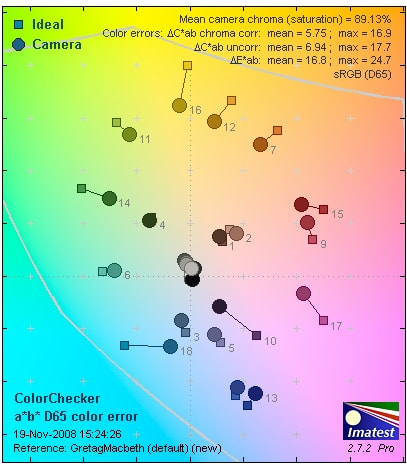
***
*****Resolution **(1.82)
With our 3000-lux lighting setup trained on a resolution chart, we found that the 1050 SW could capture a maximum 531 lw/ph horizontal and 339 lw/ph vertical resolution, an acceptable though not impressive result.
**Motion ***(1.5)*
For our final video test we take a few minutes out of our hectic schedule to admire the passing traffic on a busy road, capture some of this hustle and bustle on video, then view the results on a TV monitor. The 1050 SW performed well here, with no significant stuttering or blurring visible as the cars whizzed by on screen.
Here at last is a category where the 1050 SW surpasses the competition, albeit by a modest margin for the most part.
Olympus 1050 SW Video Scores

Speed and Timing
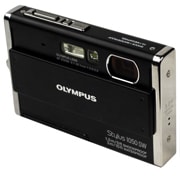
**Speed/Timing
**Fishermen and photographers alike like to fall back on that old chestnut, 'You should have seen the one that got away,' but it's not always a lie, and it's not always your fault. If the camera is slow to respond, you're going to miss key shots, even if you have the reflexes of a cougar. To fend off frustration, we test the speed and alacrity of each camera in several areas.
**Startup to First Shot ***(6.0)*
You see a photographic opportunity, you pull your delightfully portable camera out of your pocket, turn it on and wait till it's ready to take that first picture. In this case, you'll have to wait nearly four seconds on average, which doesn't sound like much on paper, but can be excruciating when Bigfoot is loping away into the underbrush before you can press the shutter.**
Shot-to-Shot (7.27) *
*The 1050 SW provides two very different continuous shooting modes. The first, shooting at the camera's full 10-megapixel resolution, is a leisurely affair, sedately taking one photo every 2.7 seconds or thereabouts. Our scoring is based on full-resolution shooting, and that's not a rate that's going to rate well, but we did try out the alternative, truly high-speed mode in addition. This mode lowers resolution to 3 megapixels but in exchange captures shots at a smoking 6 frames per second. They might not be suitable for gorgeous 11 x 14 prints on your wall, but we like this mode for capturing sports and**high-velocity toddlers alike.
**Shutter-Shot** (1.81)
You're not likely to miss a shot entirely due to the delay between pressing the shutter button down and having the camera actually record an image, but at a little over a second, you may notice the lag.**
Processing***(1.35) **
*After taking a photo, the camera has to process the data and store it to memory before you regain control of the camera for another shot. For most cameras, this moment occurs when the photo you just took appears on the rear LCD screen for review. Olympus offers a bit more instant gratification is this regard, letting you see the review image nearly instantaneously. Unfortunately, writing the photo file out to a pokey xD memory card is anything but instantaneous: it took over 6 seconds on average before the process was completed, which is basically a digital eternity.
Components
**
Viewfinder***(0.00)*
The 1050 lacks an optical viewfinder, no surprise in a tightly packed compact camera. While it may be par for the course to omit this feature at this point, it's worth remembering the advantages an optical viewfinder offers, allowing a clear view while lining up a shot even in the brightest sunlight, like on a ski slope, where this water-resistant, freeze-resistant camera is right at home.
LCD Screen*(6.25)*
The 2.7-inch LCD screen is slightly smaller than the 3-inch versions we're finding on many compact cameras today, but it is bright and sharp enough for the job at hand, with a business-as-usual 230,000-dot resolution. Screen brightness can be adjusted to five different levels via the Setup menu, which makes a meaningful difference, particularly when shooting outdoors. The Olympus marketing mavens have dubbed their display a 'HyperCrystal LCD,' and while having the word 'hype' right in the product name makes a snarky remark incredibly tempting, journalistic restraint requires us to report that the screen holds up unusually well under bright sunlight, with little glare or sign of the the washed-out look we find in most compact camera LCDs. And while holding a camera at an extreme angle usually means the screen colors shift or black out altogether, the Olympus display was accurate and legible no matter how we twisted and turned it.
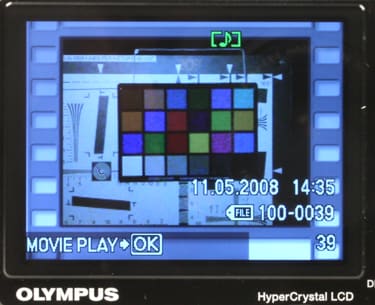
While shooting, pressing the DISP button cycles between four different views. One is a nearly clean screen, with only the focusing reticle visible. A press of the button adds on-screen readouts for shootng mode, flash mode, white balance setting, image size and shot number, plus a 9-square grid overlay we found very useful for precisely lining up shots. Another press dismisses the grid and brings up a histogram just below the middle of the screen, while another press removes the histogram but keeps the rest of the shooting info.
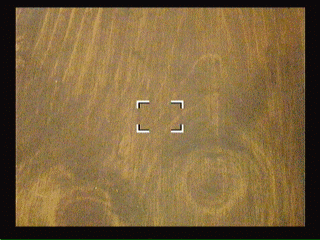
The LCD toggles between four shooting display modes.
**
**Flash ***(3.75)
*The small flash unit sits alongside the camera lens, with some space in between for the focus assist/ timer lamp, and this arrangement seemed to effectively eliminate red-eye, even in very dark rooms. Just in case, you can turn on red-eye mode, which puts out a blinding series of pulses to shut down your subject's iris and guarantee a pained expression when the final shot is taken. There are no fancy flash sync modes, just auto, red-eye, fill-flash (i.e., mandatory firing) and flash off.
The light output is pretty intense for such a small strobe, though Olympus doesn't offer a guide number in the product specs. We did find an objectionable hot spot in the middle, though, particularly when shooting in a room where the wall didn't have a perfectly matte finish. Olympus claims a flash cycle time of approximately 3.5 seconds. Our timing came up about a second longer, which is still pretty good; we've seen compact camera flashes take a good ten seconds to recharge.
**

The flash is small and powerful, but coverage isn't very even.
**Lens **(3.50)
The 6.mm-20.1mm lens (equivalent to a 38-114mm on a 35mm camera) has an f/3.5 maximum aperture at its widest setting and f/5 at maximum zoom. As often happens with compact cameras, the zoom isn't smooth and freely adjustable, but moves into preset lengths as you press the control. There are nine zoom steps in all. If you want finer control, you're just going to have to walk closer or further away from your subject.
We like the full-camera-width protective cover that shields the lens and flash when not in use, and also acts as an on-off switch. It requires no finicky fumbling to slide this cover up or down, and it moves into place with an authoritative snap.
In addition to optical zoom, two types of digital zoom are available. What Olympus calls 'Fine Zoom' produces higher apparent zoom ratios by capturing a progressively smaller section of the sensor, lowering image resolution as you zoom in, The maximum zoon in this mode is 17x, at a resolution of 640x480. You do end up with a lower-res image but, on the plus side, you don't experience the ugly pixelation caused by standard Digtial Zoom, which is also available up to 15x magnification.
Macro mode, which includes three settings, works well. Choosing the standard macro mode allows focusing as close as 7.9 inches (20 cm) from the subject. The super macro mode lets you get thisclose to the target, as near as 2.8 inches (7 cm). Finally, you can engage an LED light with the super macro mode. The bright LED light causes too much glare to be useful shooting anything with even a slightly shiny surface (even postage stamps proved problematic), but it does allow handheld shots of small objects that you'd never be able to achieve without the light. Overall, all three macro modes produced impressively sharp close-up results.
What's sorely missing, though is true image stabilization, whether through shifting lens elements or the image sensor itself within the camera. There's a digital image stabilization mode, available in both still and movie modes, but this simply boosts the ISO setting to enable faster shutter speeds, a poor substitute for true hardware-based image stabilization, particularly in a camera that's likely to be used in active settings.
Design / Layout
Model Design / Appearance*(8.00)*
The sliding lens cover may not be an aesthetic breakthrough anymore (Sony has gone through a few model generations using this design concept), but it still brings some flair to the party, and even has some practical benefits when it comes to protecting camera components and supplanting the tiny on-off switch. For the color-coordinated among us, this Stylus comes in stylish blue, silver, black and champagne. The camera is solidly constructed, with clean architectural lines: we'd be happy to be seen fishing this one out of our white dinner jacket during a swank DigitalCameraInfo.com black-tie affair.
Size / Portability (7.75)
At 5.2 ounces (152 g) and 3.7 x 2.4 x 0.9 inches (93 x 62 x 22.6 mm), the 1050 SW feels substantial in your hand, but isn't heavy enough to diminish its pocketable portability. **
**
Handling Ability(8.00)
We like the feel of the 1050 SW very much, whether you have dainty digits or generously proportioned paws. The camera depth of nearly an inch provides a firm hold top and bottom, and the lens and flash positions would be nearly impossible to obscure with a poorly placed finger. The shutter is the furthest-right control on top of the camera, making it easy to press when holding the 1050 SW either horizontally or vertically (there's even a little wedge-shaped bump beside the shutter button to keep you from accidentally pressing it). As for the vaunted 'tap' control feature, let's deal with that in the next section.
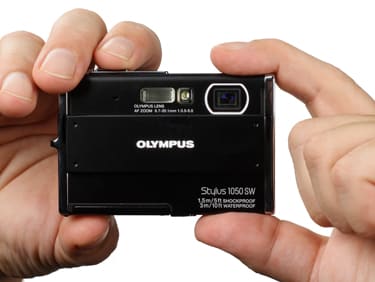
The 1050 SW is compact but still easy to hold securely.
**Control Button / Dial Positioning / Size ***(8.50)*
The camera controls are well designed, with only a few minor peculiarities. Buttons have the right balance between give and resistance, making accidental presses unlikely while providing definite feedback when you have successfully entered a command. The four-way controller is a bit cramped, particularly the top button (exposure compensation), which lies perilously close to the mode dial. As long as you haven't gnawed away your thumbnail, though, you shouldn't have trouble hitting the targets, or the four rounded buttons positioned between the four-way controller's branches. The mode dial has a gnurled edge that's easily accessible by sliding your thumb along the right side. The only button that's particularly problematic is the recessed power button on the top surface, which is difficult to find and press quickly, but with the big, easy-to-use sliding lens cover doubling as an on-off switch, a flaw here is inconsequential.
And what about the Tap Control that stands as the camera's marquee feature? It seems more clever than practical to us. The idea is interesting: by tapping on the camera top, sides and back, you can trigger different functions and settings. The main problem here is the fact that the functions controlled by tap aren't programmable: Olympus has decided what makes sense for you, which includes adjusting the flash mode (right-side tap), switching to playback mode (back tap), and turning shadow adjustment on or off (left side tap). While in playback mode, you can also tap to move forward or backward in the photo display or double-tap to turn on a slideshow. That's it, and in our estimation it's not much. Why not a tap control to adjust the white balance setting, or chose a different scene mode, or adjust exposure compensation? All three are far more useful choices than controlling shadow adjustment or flash mode. And even when using the flash or shadow adjustment tap settings, you have to not only tap the right or left side, but double-tap the top to confirm your choice. There is an exception to this tap control scenario: in the Snow scene mode, tapping the back of the camera twice takes a picture after a 2-second delay. This makes perfect sense for the mitten-bound photographer, but why not let you choose to use it when you're not in Snow mode? All in all, tap control is too much trouble for too little convenience.
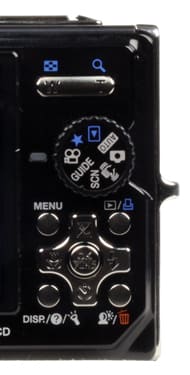
Controls are tightly packed
together but still manageable.
Menu (6.50)
The menu system seems a bit complex for what is essentially a fairly simple camera. There is a clearly marked MENU button on the back, but what you'll see when you press it depends entirely on where the mode dial rests at the time. While pondering the available menu selections, pressing the DISP button brings up a text block explaining your choices, a feature that should be helpful to newbies bravely venturing off the Auto mode path.
The full-auto and auto exposure modes are accompanied by simliar menus, except full auto mode blanks out the Camera Menu section, which includes white balance, ISO, drive, zoom, metering and focus mode controls. The Image Stabilization mode is similar to the auto exposure mode, except the ISO setting option is unavailable, since the camera takes over this setting. In all three shooting modes, the Panorama and SCN modes are displayed in outline form but unavailable: we wonder why they're shown on-screen at all. The illustration below displays the Camera Menu options:
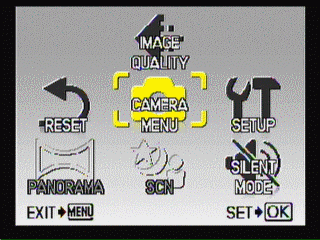
The Reset option, available in both the Camera Menu and Playback Menu, returns all settings to camera defaults. The Setup option leads to identical menus, whether selected from Camera or Playback mode, as shown below.
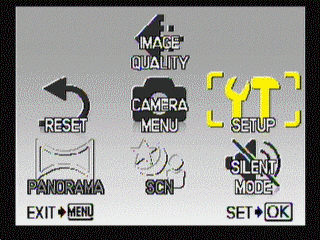
Several menus are available in Playback mode. The Playback Menu itself offers only three choices: protect a file from erasure, rotate an image, and add a four-second audio clip to an existing photo. Perfect Fix, a separate selection available from the top mode menu, provides lighting and red-eye fixes. The Edit submenu offers image resizing and cropping, color edit and a calendar creation utility.
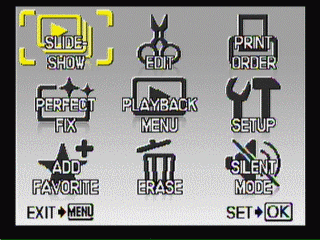
When the camera's in SCN mode, pressing MENU provides an illustrated listing of the 23 available scene modes (detailed in the Custom Image Presets section here). In Guide mode, menu brings up the following list of plain-English choices to allow users to adjust image controls without necessarily understanding them:
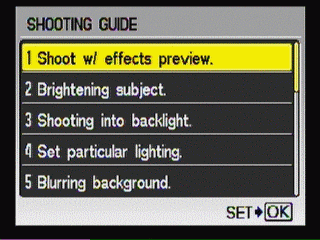
The Movie Mode menu offers white balance setting, digital zoom on/off, meter mode and digital image stabilization (DIS) on and off.

The Favorites mode (represented by a star on the mode dial) has only two choices: store a photo as a favorite in built-in camera memory, and start a slideshow of your favorite shots.
In addition to the menus shown above, the Olympus Stylus 1050 SW also includes a quick menu, which the documentation refers to as the FUNC menu, not in misspelled tribute to George Clinton and Parliament Funkadelic, but because you press the OK/FUNC key in the center of the four-way controller to access it. In any shooting mode, this brings up an overlay with shooting mode, ISO, continuous shooting setting, metering mode and image size and quality arrayed down the left side. As you cursor down this column, your available options for each setting are shown at the bottom of the screen. Move the cursor left and right, hit the OK button and you've changed your setting. It's fast. It's easy to understand. We like it a lot. The version for auto exposure mode, which offers the greatest number of live options, is shown below.
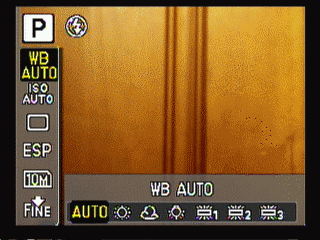
Ease of Use (7.75)
The basic camera menu system is straightforward, easy to read and simple to navigate, due in part to the fact that there just aren't that many options available. We like the availability of on-screen text explanations of menu choices (available by pressing the DISP button), and we found the quick menu on-screen overlay mode particularly useful when you understand the available settings and just want to make adjustments without fussing through a multi-tiered menu tree.
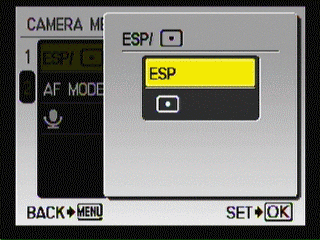
Modes
Auto Mode (8.50)
The full Auto mode locks out the camera control menu entirely, limiting the user to adjusting image size and quality plus functions mapped to the four-way controller (exposure compensation, flash mode, self-timer and macro mode). We think that provides a reasonable balance between idiot-proofing to protect the novice and allowing some exposure control to adjust for clearly unbalanced lighting. The fact that exposure compensation adjustments are reflected live on-screen makes this function accessible even without deep photographic knowledge.
There is also a program mode, though in the manual this goes by the name 'Shooting with optimum value and shutter speed,' and it's identified with a meaningless white camera icon on the mode dial. This setting lets the camera handle shutter and aperture settings, but allows the user to adjust white balance, ISO, burst mode and metering mode in addition to the controls available in full auto.
The Digital Image Stabilization mode is an ISO-boosting option, rather than true sensor- or lens-shift image stabilization, which the camera notably lacks. Instead of offering this as an option that can be toggled on and off in the regular shooting modes, it's presented as a separate option on the mode dial, which seems like a poor use of space, but not a major faux pas.
**Movie Mode ***(7.50)*
Video can be shot at 640x480 (VGA) or 320x240 (QVGA) resolution, each at 30 or 15 frames per second. The results are stored in a Motion JPEG (MJPEG) file. White balance and metering mode can both be set in movie mode,while digital zoom, shadow adjustment and digital image stabiilization can be turned on or off. Sound is always recording while shooting movies, and (no doubt as a result) optical zoom is prohibited, though you're free to use digital zoom.
Drive / Burst Mode*(6.0)*
There's good news and bad news on the burst mode front, corresponding to the two available modes. The regular sequential shooting mode works at any image quality setting you choose, but it works slowly: we got only one shot every three seconds shooting at full resolution without flash. On the other hand, there's a high-speed burst option that cranks out the shots with impressive speed. We got over six shots per second in this mode, up to 24 sequential shots at a time, though the resolution is limited to 3 megapixels. Even at that reduced resolution, though, this high-speed burst should prove very useful when trying to catch the perfect moment while snorkeling or snowboarding.
There is also a basic self-timer function. It's preset for 10 seconds (most cameras offer a choice of 2- or 10-second interval, at least) and has to be reset after every shot, inconvenient if you want to take with a series of photos using the timer. One positive note: the self-timer is conveniently available via the bottom button of the four-way controller, rather than having to dig through camera menus.
**Playback Mode ***(8.75)*
Playback mode offers four screen variations based on the DISP button. One provides date and time, image quality and file name, with shutter speed and aperture, exposure compensation, ISO and white balance settings added if you press DISP once. A second button press removes all distracting overlays, while a third press provides a thumbnail view of the photo over a histogram, with the shooting data displayed on the right side.

The zoom control magnifies images up to 10x on screen when in playback mode. Zooming out from a full-screen image displays first four thumbnails, then nine, then sixteen, then twenty-five thumbnails, and finally a calendar display sorting images by the date they were taken. We find this kind of calendar display very helpful, and while it may take a few button-presses to get there, it's better than having to dig through the menu system to find it.
While browsing through your photos, the left and right arms of the four-way controller move you forward and back as expected, but you can also press up on the controller to jump ten photos ahead or press down to jump ten photos back, a useful shortcut.
Custom Image Presets*(8.00)*
There are 23 scene presets altogether, including all the usual suspects (portrait, landscape, sport, fireworks), but with a few unusual offerings as well. First off, since the 1030 SW was released, Olympus has added a Smile Shot mode, where the camera pauses after you press the shutter until your subject grins, then rapidly fires off three shots There are a few modes tailored to the usage patterns appropriate to a waterproof camera, including Beach & Snow, Snow and Underwater. The 1030 SW offers more underwater options, including wide and macro options, but then again, these are more scuba-oriented features, appropriate to depths where the 1050 SW will not boldly go, where the dual wintry modes reflect the more snowboarder-oriented appeal of the 1050 SW.
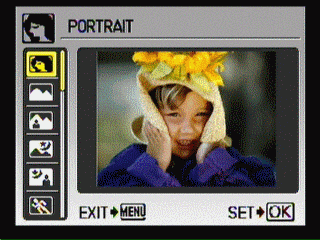
Auction mode takes three sequential shots with varied exposures at a web-postable 640x480 resolution, but the exposure difference between the shots is minimal, rendering this option uninteresting. The two Shoot & Select choices are burst-mode variations. The first uses high-speed continuous shooting mode (at 3-megapixel resolution) to fire off a string of shots and when you're done shooting, displays the results on screen to let you choose which images to save and which to discard. The second Shoot & Select mode sticks with slower, full-res images, even firing the flash if needed, then offers the same keep-it-or-kick-it display. Pre-Capture Movie is dedicated to creating teeny-tiny videos, constantly keeping 2 seconds of video in a buffer, then adding an additional 5 seconds after you press the shutter and ultimately saving the completed 7-second sequence. The pre-capture part is a clever idea, but the 7-second time limit makes it just about worthless.
The manual does a poor job of explaining what each of the scene mode settings mean. On-screen help is available, either by pressing the DISP button or just lingering on a particular choice for a few seconds, but even here more precise explanations would be helpful.
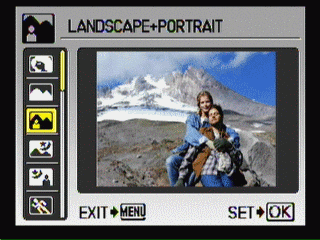
Control Options
Manual Control Options
If you're looking for a lot of manual control, this is not the camera for you. Beyond exposure compensation and white balance presets , you're pretty much out of luck: no manual focus, no aperture-priority, shutter-priority or full manual exposure settings. Of course, the intended user probably has little time for such photographic fiddling, what with evading poolside splashes, snorkeling, skiing, snowboarding and such.
Focus
Auto Focus (6.25)
The camera supports spot focus and what Olympus calls iESP, which identifies the most prominent subject in the frame wherever it's positioned and focuses accordingly. Face detection can also be selected for auto focus; up to 16 individuals can be recognized at a time.
Manual Focus (0.00)
No manual focus capability here.
ISO (9.75)
Available ISO settings range from 80 to 1600 and, while the jump from ISO 80 to the next-available 100 setting is barely a move at all, we did find some measurable improvement in image noise and dynamic range at the lower setting. Hands-on ISO control is limited to program mode. Full auto mode sets the camera to auto ISO, and image stabilization mode automatically boosts ISO to assist in fighting camera shake.
White Balance (6.50)
The 1050 SW offers automatic white balance plus six user-selectable white balance presets: sunlight, shade, incandescent, fluorescent1, fluorescent2 and fluorescent3, though there's no indication what type of fluorescent bulb corresponds to each of the presets. There is an on-screen active preview as you change the white balance setting, though, so you can see the effects of the changes you're making and judge accordingly.
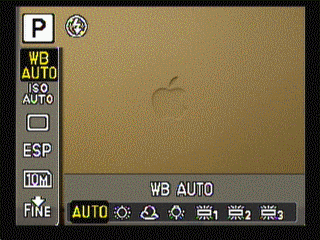
There is no flash preset, and no option to set the white balance manually by shooting a neutral card under current lighting conditions. The flash preset is fairly unimportant, especially since the camera performed well on auto when shooting with flash, but we miss the ability to set a manual white balance, which is often found in cameras in this price range.
Exposure*(2.5)*
While there is no manual exposure control, at least exposure compensation settings are available, in a ±2EV range. And like the white balance setting, you can see the effect of exposure compensation settings in a live on-screen preview, a worthwhile feature.
Metering (4.75)
Spot metering measures the lighting at the center of the frame, while the oddly named iESP mode meters the center and the rest of the frame separately and attempts to balance the two for a pleasing overall reading. Face detection mode is also available to prioritize exposure for the people in your pics.
Shutter Speed (4.00)
The shutter speed range is very limited. The fastest available setting is 1/1000, not really high enough when shooting fast action in blazing sunlight. The slowest is 1/2 second, though a 4-second exposure is available via the Night Scene preset. Considering the camera's poor image noise performance, we can understand why the maximum shutter speed is so limited, but more latitude would have been welcome, especially if you're thinking about tripod-mounted low-light shots to chronicle adventures in harsh climates.
Aperture* (3.50)
*The maximum aperture setting is f/3.5 at the widest lens setting and f/5.0 at maximum zoom. The relatively slow lens just serves to exacerbate the low-light-shooting limitations of the 1050 SW. The camera actually fared pretty well in our low-light lab tests, but that employs tripod-mounted shooting. When shooting handheld, a faster lens lets you shoot at a higher shutter speed, making image blur from shaking hands less likely – but this is not a fast lens, and the camera's lack of optical image stabilization only magnifies the problem.
Image Parameters
Picture Quality / Size Options (5.30)
Image size ranges from 10 megapixels to 0.3 megapixels as follows:
There are also two JPEG compression settings, Fine and Normal. The camera doesn't shoot in RAW file format.
Picture Effects Mode (3.75)
The 1050 SW doesn't offer control over color, saturation, contrast or other image qualities while shooting. There is an extensive feature set for creating panoramic images, though, which seems appropriate for an outdoorsy camera.
There are three approaches to building the perfect panoramic picture:
Combine in Camera 1: This method brings a degree of automation to the process. After you take your first photo, a target marker appears on screen to the left or right. When you line up an on-screen pointer with this target marker, the camera automatically takes a second shot. Follow the same procedure one more time and the camera takes over, combining the three images and saving the result. If you prefer a two-shot panorama, just press the Menu button after the second photo.
Combine in Camera 2: Here you set the autopilot aside and take three photos manually. After each shot a reference section of the image remains visible at the edge of the frame to help line up the next image in sequence. After the third photo is taken, the camera stitches them together and saves the result.
Combine in PC: Relying on the included OLYMPUS Master 2 software on the computer offers additional levels of control. You can stitch together photos shot by panning vertically as well as horizontally, and up to ten images can be combined. What you sacrifice, though, is the on-screen reference to help line up the next shot properly. You have to eyeball the alignment, and let the computer software cover up any inadequacies with clever digital processing.
There is also a 'shadow adjustment' feature available while shooting, which works in conjunction with the face detect system. If shadow adjustment is on, the camera will identify people in your photo and, if they are backlit and in danger of being underexposed, compensate by damping down the background and brightening the faces. Olympus apparently thinks this is a fairly important function, since it's available via a dedicated button and through the tap-control interface. We can see the utility when shooting out in the snow, but in less extreme environments (i.e., backlit shots not set against blindig white snow), it didn't make much of a difference.
There are a few image alteration options available while in Playback mode, including resizing (to 640x480 or 320x240), limited cropping (only two size choices each for portrait and landscape) and color edit, which creates a copy of an existing image with black and white, sepia or one of two saturation effects applied.
The Perfect Fix option in Playback mode includes automatic redeye correction and lighting fix, an automated correction that attempts to bring up light levels in especially dark areas.
This is a very barebones selection of in-camera editing options. And while we're perfectly comfortable carrying out our image-tweaking on our computers, many point-and-shoot owners like to print (or have their images printed) right from the camera, in which case the extensive image editing options you'll find on a compact Nikon, for example, have real value.
In movie mode, you can create an index image with a nine-image grid of frames taken from your video. You have no control over which frames are selected, and there's no way to grab a single frame from a video, which would seem to be a lot more valuable. Still, the index page is better than nothing.
There is one more stray fun feature to mention: the Calendar utility, which lets you create a composite image combining a photo you like with a monthly calendar page to print out. As a cubicle enhancement tool, we like this capability, and it's simple enough for anyone to get good results.
Connectivity / Extras
Connectivity
Software (6.50)
The camera comes with versions of the Olympus Master 2 suite for both Windows and Mac, and a measly 15-day trial of Muvee, an automated movie editing program for Windows. Unlike the usual bundled software, Olympus Master 2 will actually be worth using for many people. It's image organizing and viewing functions are attractive and well designed. You get support for automated photo email creation and YouTube uploading, along with extensive photo editing options including automated and manual adjustment of brightness and contrast, color balance, hue and saturation, image sharpening, and even lens distortion correction. You still can't undertake the kind of pixel-by-pixel and area-by-area corrections available through Photoshop Elements or other sophisticated image editing programs, but on the full-photo-fixing level, we think Olympus Master 2 has merit.
Jacks, ports, plugs*(2.00)*
There's a single IO port for connecting to a TV, a computer or an optional DC power adapter and, while the compartment is well sealed against the elements, criticism can still get through the waterproof barrier. Specifically, Olympus uses proprietary cables for these connections, hard to replace and tough to leave behind when traveling; your laptop probably has an SD card reader, but the 1050 SW uses the less popular xD card format, meaning most of us will cable up to the USB port for image downloads.
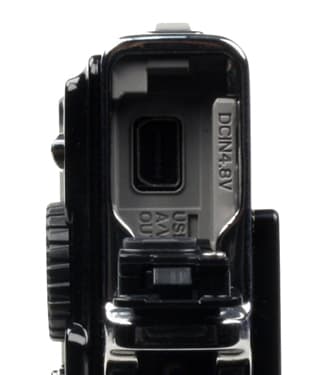
If you lose the proprietary cables you'll find it's a significant problem.
*Direct Print Options* (4.00)
The direct print options are superior to the minimum-requirements implementations we usually see. Connect the 1050 SW to a PictBridge-compatible printer via USB and, in addition to outputting standard full-sheet photos, you can print several images on a single sheet of paper, create pages of thumbnail-sized images to serve as index prints, and crop images before printing. The camera menus to choose all these goodies are nicely organized and simple to use. Easy Print mode simply outputs a single picture using the printer default settings. Custom Print lets you choose paper size, specify bordered or borderless printing, choose from single or multi-image printing, set up an index print, determine the number of prints for each image and decide whether or not to overlay the file name and/or date taken on the print.
You can also create a DPOF print order, a file on your memory card that tells a photo printing service what you'd like without messing with paper order forms.*
Battery* (5.00)
The slim LI-42B lithium ion rechargeable battery provided is supposed to last for about 200 shots, according to Olympus, and while this seems a bit optimistic based on our experience testing the camera, it's not wildly out of line. It's also not particularly impressive, especially if you like turning on the camera and showing off your photographic feats of derring do to your admirers. We'd say a spare battery is pretty much an essential, and thankfully it's not a horrifically expensive one: Amazon has the Olympus-brand version for under $35.
What bothered us about the Olympus battery more than short life, though, is how perfectly simple it is to insert it into the camera the wrong way. Flip it backward or forward: it fits just fine. Even turning it around so the contacts are pointing away from the camera doesn't stop you from slipping it into the slot and closing the cover. It's not that you're going to hurt the camera if you make a mistake (the right way, we should mention, is with the word 'Olympus' facing the front of the camera), but particularly if you're wearing gloves (this is the tap-feature camera, right?) or hanging out in harsh environments, a little additional idiot-proofing would go a long way.
*Memory* (2.50)
The 1050 SW relies on xD memory cards, which are not our favorite format. The top xD capacity is just 2 gigabytes, versus the maximum 32-gigabyte capacity of SDHC cards. The xD cards are also harder to find, and cost more per gigabyte than either SD cards or CompactFlash. We recently shot with a Fujjfilm camera that accepted both xD and SD cards in the same slot, which struck us an ingenious solution, but not one Olympus has adopted to date. The camera does ship with an adapter for using microSD cards, the format typically used for cellphones, but that doesn't solve the pricing and capacity issues.
The camera also includes a smidgen of built-in memory (41.6 megabytes, to be exact), but this is here basically as storage for the favorite photo feature.
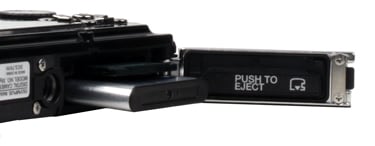
The battery and memory card share a waterproof bottom compartment.
Other features (8.50)
*Torture and Abuse Resistance *– The primary reason to purchase the Olympus 1050 SW is its ability to stand up to harsh environments without flinching. Thanks to a combination of metal construction, waterproof seals and design smarts honed over a line of weather-resistant cameras stretching back several years, the 1050 SW offers these hardy specs:
Waterproof to a depth of 10 feet (3 meters)
Freezeproof down to 14 degrees Fahrenheit (-10 Celsius)
Shockproof to withstand a 5-foot (1.5-meter) drop
While our testing budget wouldn't cover a fact-finding trip to a snorkeling destination, we did have an alternative body of water at our disposal (OK, so it was a bathtub), and even vigorous handling below the surface failed to find fault with the camera's seals. We used refrigeration to bring the camera temperature down to around 14 degrees (measured with an infrared thermometer) and, here again, the Olympus claims held up: even the feel of the buttons remained constant as the temperature dropped. As for shockproofing, that was easy to test, and we're happy to report that our review unit will be going back to the manufacturer unscathed.
Voice annotation - You can set the camera to record a 4-second voice clip after taking a picture, which can prove useful if you're on the go and want to remember something about the circumstances under which the picture was taken: the address, for example, or which of your friends was buried under the avalanche you photographed while skiing. You can also go back in playback mode and add a 4-second voice annotation.
Alarm clock - We hear you scoff, but if you've ever stumbled into a hotel late at night and found the alarm clock was as difficult to set as the trigger mechanism of a thermonuclear device, you'll understand the advantage of having your own easy-to-adjust alarm clock in tow. And why carry a separate travel alarm when your camera can do the job?
Overall Impressions
Value (7.00)
For the right audience, the 1050 SW is a nice deal: stop worrying about splashes around the pool, strap it to your wrist when you go surfing, bring it up the mountain and back down again in a flurry of fine powder. The lab results aren't all we'd like to see, but out in the great outdoors under challenging conditions, it's a question of getting the shot with a weatherproof camera or not getting the shot at all, and $300 seems reasonable under those circumstances. If all you want is a cool-looking little camera, though, there are other, less ruggedized options that offer better picture quality and a broader feature set at the same price, or less.
Comparisons
[

](https://www.reviewed.com/cameras/content/Fujifilm-FinePix-F60fd-Digital-Camera-Review-19349.htm)
**Fujifilm F60fd – **This $299 model offers a well-constructed metal body, albeit without the weatherproof specs of the Olympus. It has a larger screen than the 1050SW, at 3 inches versus 2.7, and higher resolution (12 megapixels versus 10). In a head-to-head comparison, what catches our attention are the F60fd's superior performance in color accuracy and resolution. Still, there are better-performing cameras than either of these available at the same price (notably the Samsung below).
[

](https://www.reviewed.com/cameras/content/Olympus-Stylus-1030-SW-Digital-Camera-Review-18802.htm)
Olympus Stylus 1030**SW– **The 1050 SW is not the camera Olympus would put up against Jack Bauer-like abuse: that honor goes to the 1030 SW, which is waterproof to 33 feet (10 meters), shockproof from a 6.6-foot (2 m) height, and adds a 'crushproof' claim to withstand 220 pounds of pressure (the two cameras share a 14-degree temperature resistance). To achieve these brawnier specifications, the 1030 SW is larger and heavier than the 1050 SW, and costs an additional $50. You get more than brawn for the extra bucks, though: you also get superior performance in nearly all of our lab tests. Unless the extra ounce of weight seems burdensome to you, we'd be inclined to spend the extra cash and go with the 1030 SW.
[

](https://www.reviewed.com/cameras/content/Pentax-Optio-W60-Digital-Camera-Review-19041.htm)
Pentax Optio W60**–**This attractive 10-megapixel model is the Pentax entry in the ruggedized fray: waterproof to 13 feet (4 meters), freezeproof down to 14 degrees F (-10 C), resistant to dirt, sand and dust. The Pentax zoom lens is more powerful (4x versus 3x for the Olympus 1050 SW), and the price is slightly higher ($329.95 versus $299.99). The lab testing results fall in the Optio's favor in nearly every match-up, which gives this camera a decided edge at a very small price premium and virtually the same size and weight.
[

](https://www.reviewed.com/cameras/content/Samsung-TL34HD-Digital-Camera-Review-19461.htm)
Samsung TL34HD**–**This is our leading model at this point for point-and-shoot landlubbers. Unlike the 1030 SW, this one offers extensive manual controls, solid test performance across the board, a touch-screen LCD interface that's both fun to use and practical, and effective optical image stabilization that's notably missing in the Olympus, all at the same $299 price. Of course, if you accidentally drop the TL34HD in a swimming pool at some point, you may wish you'd bought the Olympus instead.
**
Who It’s For ***
Point-and-Shooters* – The camera is easy to use, with a wide range of scene modes to help tailor casual clicking for superior results. Good looks and solid metal construction are additional points in the 1050 SW's favor. Unless you fear meteorological mischief, though, there are plenty of higher-performing, lower-priced point-and-shoots on the market.
Budget Consumers – The 1030 SW, at $300, can actually be a good deal compared to buying a camera and waterproof case separately, but it could only be considered alluring to the 'budget' buyer if laughing at the elements is a purchase priority.
Gadget Freaks – There is certainly a gadget-loving appeal to jumping into the pool with your camera, or falling down in the snow while taking snapshots without fear, but beyond this specialized capability the camera functions are very basic indeed.
Manual Control Freaks – Not a chance.*
*
Pros / Serious Hobbyists – Maybe for special waterlogged occasions but, even then, there are better choices for those who are sensitive to image quality.
Conclusion
**
Conclusion**

This is a well-constructed metal-body camera that looks stylish and sophisticated while boldy going where a less ruggedized model would fear to tread. We like the multitude of scene modes, the high-speed still mode (albeit at reduced resolution) and the panoramic photo modes, which are easy to use and turn out fun results. However, image quality isn't what it should be for $300, and there are other ruggedized cameras (including Olympus' own Stylus 1030 SW) that outperform this one at very similar prices.
Sample Photos
**Sample Photos
Click on any of the images below to view the full-sized origional image. However, please note that some of the images are extremely large (up to several megabytes) and could take a long time to download. **
**
You can browse photos taken with the 1050 SW on the following photo hosting sites.**
[

](http://search.fotki.com/?q=1050%20sw)[

](http://www.smugmug.com/search/index.mg?searchWords=1050%20SW&searchType=global&x=0&y=0)[

](http://www.flickr.com/search/?q=1050%20sw&w=all)
Specs / Ratings
**Specs Table
**{{manufacturer_specs_table}}{{raw_scores_table}}
Meet the tester

Steve Morgenstern
Editor
Steve Morgenstern is a valued contributor to the Reviewed.com family of sites.
Checking our work.
Our team is here to help you buy the best stuff and love what you own. Our writers, editors, and experts obsess over the products we cover to make sure you're confident and satisfied. Have a different opinion about something we recommend? Email us and we'll compare notes.
Shoot us an email